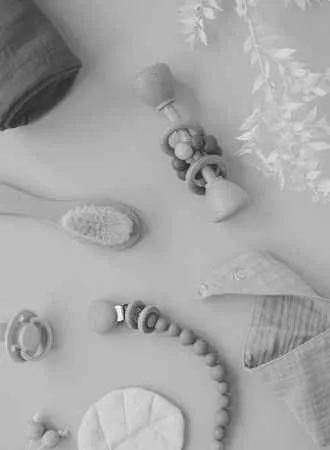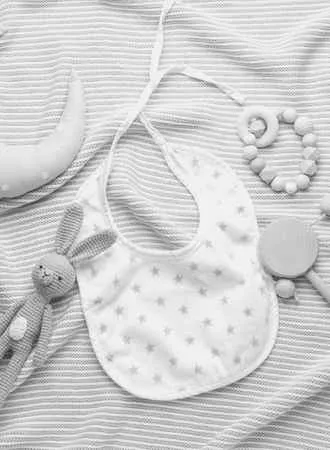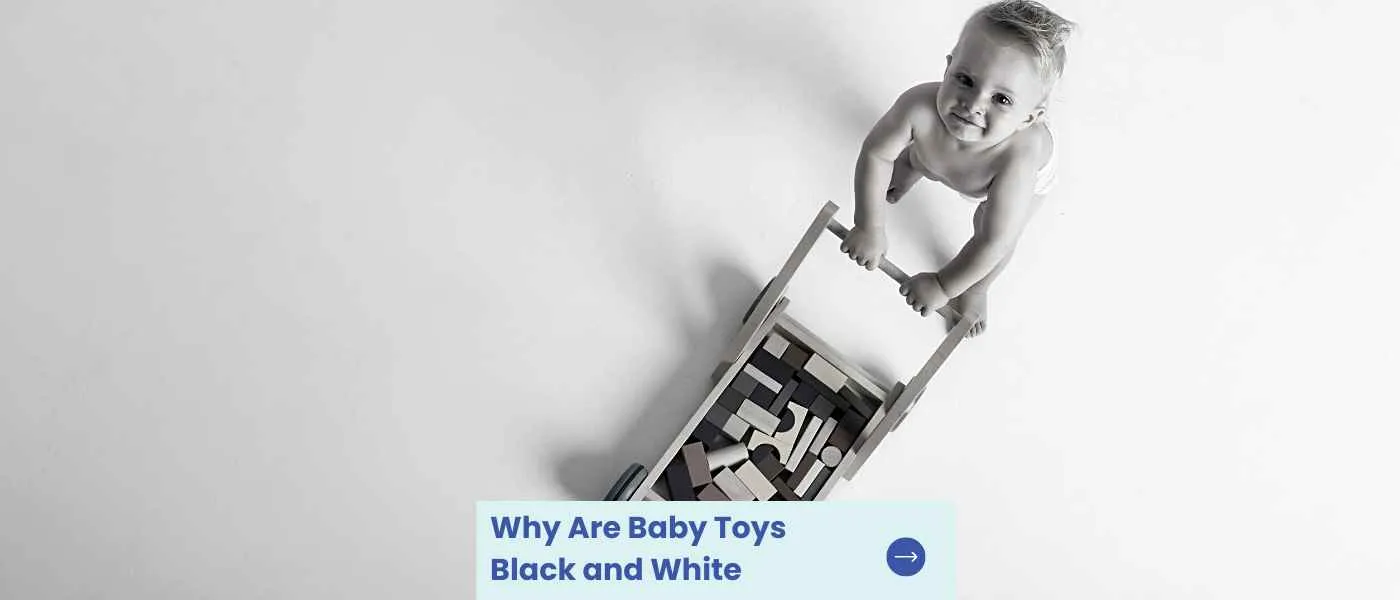Baby toys in black and white colours have been used for decades, as research has shown that a baby’s vision is initially attracted to strong contrast. As newborn babies are born with limited vision, their eyesight evolves over time.
So, not all toys for babies are black and white. In fact, most of them are either bright colours or pastel shades. But there are plenty of black and white books and toys available for babies, especially those aimed at newborns. So why?
Black and white toys and patterns can stimulate infant visual and cognitive development
Newborns’ color perception is limited to black, white, and shades of grey, so these colors stand out and attract their attention
Using black and white toys can help babies develop their vision, focus and attention, and cognitive skills
Black and white toys can also be used to encourage tummy time and provide the right level of stimulation for babies.
Seeing the benefits: Why black and white toys are a must-have for baby’s development
The simple answer is that babies only see in black and white (or grey) until they are around three months old. And even up to a year there are still limitations to their vision meaning they respond best to high contrast and bold patterns.
It is generally believed that exposing young babies to high-contrast images can be beneficial for their visual and cognitive development. Black-and-white images are often used because they provide a high level of contrast, which can be easily seen by infants who are still developing their vision.
This exposure to high-contrast images is thought to help stimulate the development of the optic nerves and visual pathways in the brain, which can lead to improved visual acuity and cognitive abilities.
Exposing young infants to diverse textures, patterns, and high-contrast images can be beneficial for their visual and cognitive development. This exposure to diverse sensory stimuli is thought to help engage the baby’s developing brain and improve their learning and focus.
Why Newborns Benefit from Visual Stimulation
Newborns need visual stimulation. Even though their vision is not fully developed at birth, exposing them to visual stimuli can help to stimulate their visual system and encourage its development.
High-contrast images, such as black and white images, are particularly effective at engaging and stimulating newborns, as they can easily see and process these simple patterns and shapes.
By providing visual stimulation, you can help your newborn learn about the world around them and support their healthy development.
Why black and white toys are good for babies development
High contrast black and white toys can be highly beneficial for your child’s development. Seeing toys, books or decorations in black and white stimulates their vision and helps them determine shapes and patterns. Thus making them great for cognitive development.
Because babies can see them clearly black and white toys and images also help bubba’s lengthen their attention span and improve memory and recognition.
Giving babies lots of interesting things to look at when they are tiny also helps to increase curiosity and develop their central nervous system.
These high-contrast colors are easy for babies to interpret, which helps to lengthen their attention span and improve their memory. In addition to their cognitive benefits, black-and-white toys can also help to improve a baby’s gross motor skills and nervous system development.
Monochrome toys and decor are a great starting point for your collection as they are gender neutral so you can start buying before you meet the little one and easily pass them on to friends and family. Plus black and white goes with everything so it’s easy to add in colour when you’re ready.
The first colour babies see is red, which is why many black and white toys also incorporate red. And they will be able to see the full spectrum of colours by the time they are around 5 months old. So it’s not necessary to only have black and white toys.
Bringing Black and White to Life: Ideas for Games and Activities with Your Baby
One way to incorporate black and white toys into your baby’s daily play routine is to use them as part of their sensory play. For example, you could give your baby a black and white book to explore, or a set of black and white blocks to stack and knock down. You could also introduce a black and white ball for them to roll and toss.
Another idea is to use black and white toys to promote language development. For example, you could show your baby a black and white picture book and point to the different objects, naming them and encouraging your baby to repeat the words.
You could also use black and white toys to play simple games, such as hiding a black and white stuffed animal under a blanket and asking your baby to find it.
In addition to these activities, you can also use black and white toys to help your baby learn about cause and effect. For example, you could give your baby a black and white rattle and encourage them to shake it to make noise. You could also give them a black and white stacking toy and show them how to build a tower and knock it down.
Overall, the key is to make playtime with black and white toys fun and engaging for your baby, and to provide them with opportunities to learn and develop through play.
Some of our favourite monochrome toys
One of the key advantages of black-and-white toys is that they are gender neutral, timeless, and educational. This means that they can be used for multiple children and at different stages of development. For example, a black-and-white toy may be suitable for a newborn baby, but it can also be used by an older child to learn about shapes and colors.
Grimms have a wonderful range of monochrome toys and decorations that are perfect for newborns. We love the bunting to string up in a nursery, and you can never go wrong with a rainbow. It’s the perfect stacking toy when kids get bigger and a beautiful bit of decor when they are tiny.
The three men in a boat make a great toy for little ones. It stimulates vision and cognitive development when they are tiny and is an engaging toy that develops hand-eye coordination and problem-solving abilities as they grow.
Black and white books are also perfect for babies and it’s never too early to start reading to your child. Bold shapes, high contrast patterns and faces are best for really tiny tots. And they’ll love hearing your voice and learning to associate words to the things they see.

The Perfect Playmates for Developing Gross Motor Skills!
Black-and-white toys can help to improve a baby’s gross motor skills in several ways. First, the high contrast colors of black and white can help to capture a baby’s attention, which can encourage them to move and explore their surroundings.
This, in turn, can help to improve their gross motor skills, such as reaching, grasping, and crawling.
In addition to their ability to capture a baby’s attention, black-and-white toys often have simple, geometric shapes that can be easy for a baby to hold and manipulate.
This can help to improve their fine motor skills, such as their ability to grip and hold objects.
Overall, the combination of high contrast colors and simple shapes found in many black-and-white toys can help to improve a baby’s gross motor skills by encouraging them to move, explore, and manipulate objects in their environment.
Unleashing the power of monochrome
How black and white pictures can help babies with cortical visual impairment
Black and white imagery can be helpful for babies with cortical visual impairment (CVI), but they are not a cure-all. CVI is a type of visual impairment that is caused by damage to the brain’s visual processing centres, and it can affect a person’s ability to see and interpret visual information.
For babies with CVI, black and white images can be easier to see and process than color images, because they have fewer visual distractions and are less complex.
However, not all babies with CVI will respond equally well to black-and-white images, and some may find them just as difficult to see as color images.
It’s important to work with a healthcare professional or a vision therapist who can assess the baby’s individual needs and develop a treatment plan that is tailored to their specific visual abilities.

Black and white pictures can help babies with cortical visual impairment (CVI) by providing fewer visual distractions and being easier to see and process.
Why Black and White Images are the Perfect Visual Stimulation for Babies
Babies need visual stimulation in black and white because their visual system is not fully developed at a young age. At birth, babies can only see objects that are close to their face and are in high contrast, such as black and white images. As they grow and develop, baby’s eyes and brain learn to process more complex colors and patterns.
Black and white images can provide visual stimulation for newborns and can help to exercise and develop their visual system. By focusing on high-contrast patterns and shapes, newborns can learn to track moving objects and to differentiate between different visual stimuli.
This can help to support the development of their eyesight and their overall cognitive and visual development. Providing visual stimulation through black and white images can also help to engage and calm newborns, as they find these simple, high-contrast images interesting and soothing.
Exposing newborns to black and white images or contrasting patterns can help to stimulate the development of their brain and the newborn retina. When a newborn looks at a black and white image, their brain is working to process and interpret the high-contrast patterns and shapes.
This can help to support the development of the brain’s visual system and can aid in the development of the baby’s ability to see and interpret the world around them. At the same time, the baby’s retina is also being stimulated, as it is responsible for detecting light and transmitting visual information to the brain.

By providing visual stimulation through black and white images, parents can support the healthy development of their baby’s brain and retina.
5 Fun Ways to Use Black and White Images to Engage and Educate Your Baby
Black and white images can be a great way to engage and stimulate babies, as their visual system is not fully developed at a young age and they can find high-contrast images easier to process. Here are a few ways you can use black and white images to engage and educate your baby:
- Use black and white images to create a sensory experience for your baby. For example, you could place a large, high-contrast image on the floor and let your baby crawl over it, or use different textures and materials in the image to stimulate their sense of touch.
- Show your baby black and white images of familiar objects and people, and use simple language to describe what they see. For example, you could say, “This is a cat. The cat is black and white. The cat has a tail.”
- Play a simple game of peek-a-boo with black and white images. Show your baby an image, then cover it with a cloth and say, “Where’s the cat?” and uncover the image again to reveal the cat.
- Use black and white images to encourage your baby to move and explore. For example, you could place a large, high-contrast image on the wall and encourage your baby to crawl towards it or reach out to touch it.
Overall, the key is to use black and white images in a way that is appropriate for your baby’s age and developmental stage. By using simple, high-contrast images and providing simple language and interactive experiences, you can help your baby engage with and learn from the world around them.
Black and white toys can help stimulate a baby’s visual development and promote their ability to focus. These toys can also be used for sensory play, language development, and learning about cause and effect. Choose age-appropriate and safe toys to support your baby’s learning and development.
FAQs on Black and White Toys
What are black and white toys for babies?
Some examples of black and white toys that are suitable for newborns include:
- Black and white books with high contrast patterns and images that are easy for newborns to see and focus on
- Soft, plush black and white toys that are safe for newborns to hold and cuddle
- Black and white rattles or other noise-making toys that can help to stimulate a newborn’s hearing and promote their ability to turn their head and locate sounds
- Black and white mobiles or other hanging toys that can help to stimulate a newborn’s visual tracking skills and encourage them to follow moving objects with their eyes

Do newborns prefer black and white toys?
Newborns may prefer black and white toys or black and white pictures, as they can easily see and process high-contrast patterns and shapes. However, every baby is different, and some may prefer toys with other colors or patterns.
It’s important to experiment and observe your baby to see what they respond to best. In general, it’s a good idea to provide a variety of toys and stimuli for your newborn, including both black and white toys and toys with other colors and patterns. This can help to stimulate their developing senses and support their healthy development.
Are there any potential downsides to using black and white toys with babies?
There are no known downsides to using black and white toys with babies. In fact, research has shown that black and white toys can be highly beneficial for young children, helping to stimulate their visual development and promote their ability to focus.
However, as with any type of toy, it’s important to choose age-appropriate toys that are safe for your baby to play with. Always read the label and follow the manufacturer’s instructions to ensure that your baby is using the toys safely and correctly.
Additionally, be sure to supervise your baby during playtime to ensure that they are not putting the toys in their mouth or otherwise misusing them.





